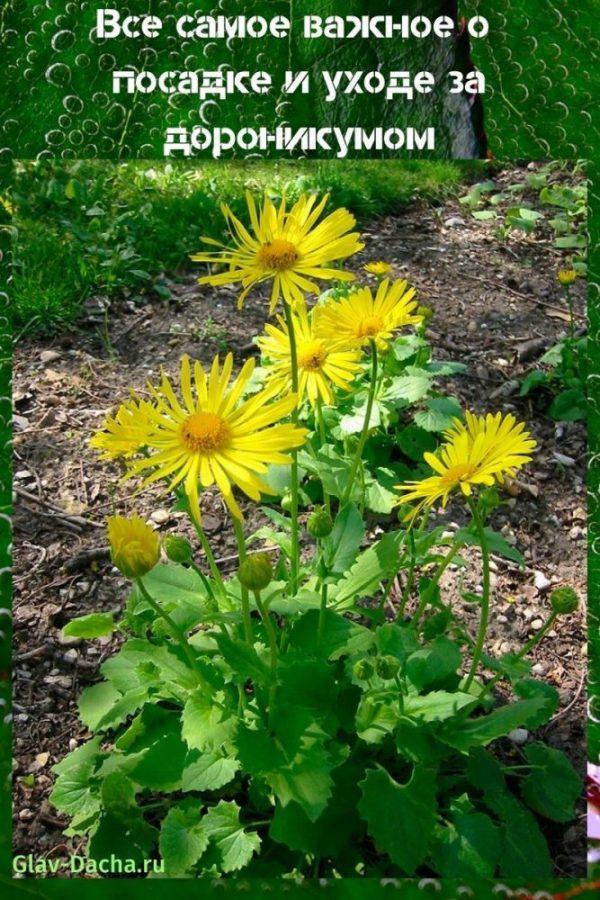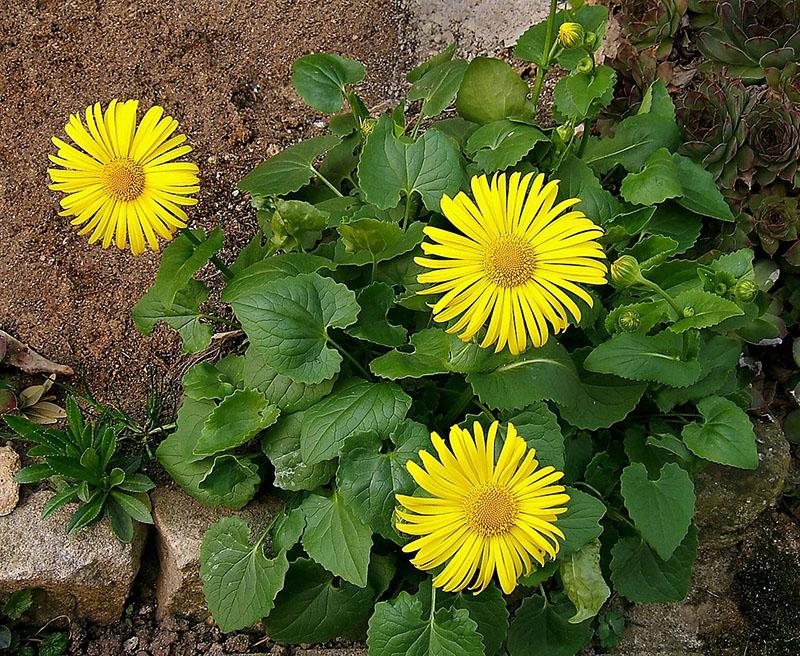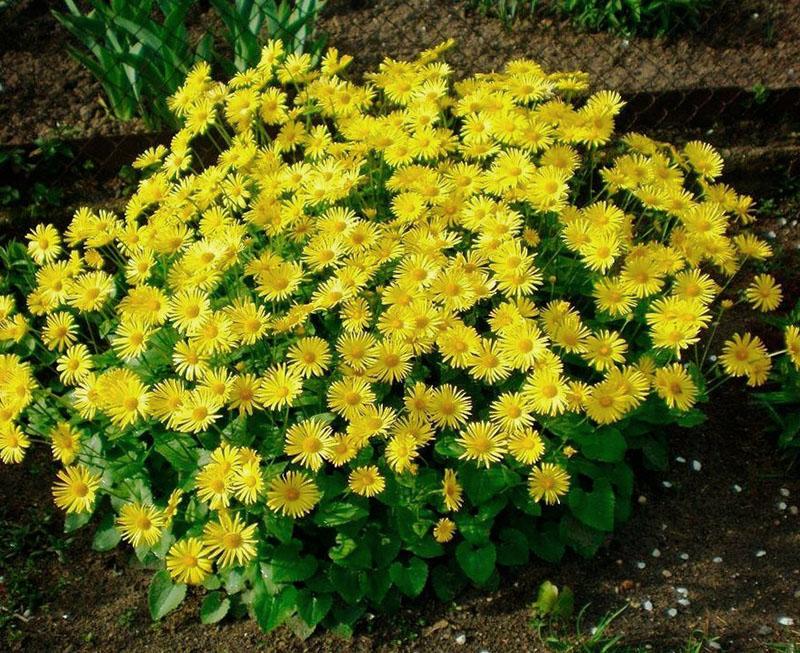All the most important about planting and caring for doronicum
 One of the first to bloom in early spring are bright yellow flowers, which are popularly called goat. Planting and caring for doronicum does not require special knowledge, so the plant is widespread. It can be seen not only in personal plots, but also in city flower beds.
One of the first to bloom in early spring are bright yellow flowers, which are popularly called goat. Planting and caring for doronicum does not require special knowledge, so the plant is widespread. It can be seen not only in personal plots, but also in city flower beds.
Plant species


Only a few species have gained particular popularity:
- Caucasian doronicum. In the wild, it is found in Asia Minor, the Mediterranean, Europe, Transcaucasia. Another name for the plant is oriental doronicum. Reaches 50 cm in height, 3-5 cm in diameter. It begins to bloom in mid-May and lasts about 40 days. Then the aerial part dries up and dies off. This species has been used in horticulture since 1808.

- Doronicum plantain. Perennial is common in Southwestern Europe. It was domesticated in 1560. Peduncles reach 80-140 cm. Leaves resemble plantain. Blooms by the end of May and pleases the eye of gardeners for about 5 weeks. Doronicum plantain does not form seeds.

- Heart-shaped doronicum. The plant is rarely found in the wild. It can be seen in the Balkans, Young Europe, Asia Minor. Cultivars can be quite compact, 15-30 cm in height. There are varieties higher than 60-80 cm. The diameter of the inflorescences is about 6 cm. The month blooms, starting from the end of May. Then it immediately fades. Planting and caring for doronicum does not require special skills. Novice gardeners should consider that it grows rapidly.

- Doronicum large-flowered. This rare species grows in the mountainous regions of southern Europe. It has been cultivated since 1710. The plant has a modest size of 15-35 cm in height. Single inflorescences reach 7 cm in diameter. It begins to bloom in mid-summer and finishes in the second half of August.

Sowing seeds
 The most reliable way to propagate a plant is to grow doronicum from seeds. Some do this in late autumn or May, sowing them in open ground. But you can get seedlings on the windowsill.
The most reliable way to propagate a plant is to grow doronicum from seeds. Some do this in late autumn or May, sowing them in open ground. But you can get seedlings on the windowsill.
In this case, work will have to start in April.:
- Pour the peat and sand mixture into a special mesh tray. Each cell should have 2-3 grains.
- Cover them with glass or plastic on top.
- Remove to a bright place. The tray should not be exposed to direct sunlight.
- Ventilate crops daily and moisten the soil with a spray bottle.
Condensation will regularly collect on the glass, which must be removed in a timely manner.
Planting and caring for doronicum
 Under favorable conditions, the first shoots will appear after 1.5-2 weeks. After that, remove the cover and move the trays to a lighter spot. Install if necessary phytolamp... This will help the plants gain strength.
Under favorable conditions, the first shoots will appear after 1.5-2 weeks. After that, remove the cover and move the trays to a lighter spot. Install if necessary phytolamp... This will help the plants gain strength.
When the doronicum reaches 40 mm, it must be thinned out. In each cell, leave the strongest, most developed seedling in your opinion. When three or four leaves appear on the seedlings, pinch.
Do not pull out the remaining seedlings, cut off the stems with sharp scissors at ground level. This will save the root system.
When and how to plant in open ground
 Spring frosts are left behind, warm sunny weather has set in the street.Now you can start planting doronicum in open ground. Usually these are the last days of May or early June. Tender plants must be hardened a week before. Take them outside every day, gradually increasing the time they are outdoors. This will help strengthen the immunity of flowers, provide them with protection from drafts, precipitation, and sunlight.
Spring frosts are left behind, warm sunny weather has set in the street.Now you can start planting doronicum in open ground. Usually these are the last days of May or early June. Tender plants must be hardened a week before. Take them outside every day, gradually increasing the time they are outdoors. This will help strengthen the immunity of flowers, provide them with protection from drafts, precipitation, and sunlight.
Let's start landing:
- Choose a shaded area away from trees.
- Loosen the soil. Spill well with water. apply fertilizer if necessary.
- Do not plant your seedlings too close. Adult shrubs reach 0.5 meters in diameter. The landing pits should not be closer.
- The depth of the hole should be such that a plant with a lump of earth can fit in it.
When planting is complete, tamp the surface of the soil and water well again.
Watering
 The root system of the doronicum is superficial. Water it often with warm, settled water. Loosen the soil often, do it carefully so as not to damage the root system.
The root system of the doronicum is superficial. Water it often with warm, settled water. Loosen the soil often, do it carefully so as not to damage the root system.
Stagnant water damages the plant. From this it will quickly wither and die.
 Delete weeds hands. To prevent them from growing, cover the surface with mulch. For this, cut grass or wood shavings are suitable. This will keep moisture in the soil longer, and no crust will form on the surface. Shortly before flowering, feed the bushes with liquid mineral or organic fertilizer.
Delete weeds hands. To prevent them from growing, cover the surface with mulch. For this, cut grass or wood shavings are suitable. This will keep moisture in the soil longer, and no crust will form on the surface. Shortly before flowering, feed the bushes with liquid mineral or organic fertilizer.
Rejuvenation
 Caring for the doronicum after planting necessarily includes rejuvenation. It must be done at the end of September at least every three to four years. A bush can grow in one place for many years. But over time, the inflorescences become smaller, lose their decorative effect.
Caring for the doronicum after planting necessarily includes rejuvenation. It must be done at the end of September at least every three to four years. A bush can grow in one place for many years. But over time, the inflorescences become smaller, lose their decorative effect.
 Dig up a bush and divide it into several pieces. For each, prepare a new place and transplant. If you want the inflorescences to be as large as possible, rejuvenate every year. Doronicum is not wrapped for wintering.
Dig up a bush and divide it into several pieces. For each, prepare a new place and transplant. If you want the inflorescences to be as large as possible, rejuvenate every year. Doronicum is not wrapped for wintering.
In good conditions, doronicum blooms twice a year. Once at the beginning of the season, and the second from mid-summer. When the inflorescence is completely wilted, remove the arrow. So you will preserve the decorative effect of the bushes.
Diseases and pests
 The greatest danger is posed by slugs, which completely eat up the foliage. To avoid pests, treat the stems with ground hot pepper or mustard powder.
The greatest danger is posed by slugs, which completely eat up the foliage. To avoid pests, treat the stems with ground hot pepper or mustard powder.
Aphids and thrips are frequent guests of doronicum. Insects feed on plant sap from the ground part of the flower. Their presence is indicated by yellow stripes and spots, deformation and premature death of inflorescences. A solution of an insecticidal agent will help get rid of pests. For example, Agravertina, Karbofos, Akarin, Aktellik.
Doronicum is susceptible to diseases such as gray rot, rust, powdery mildew. The shrub has good immunity and only gets sick under adverse weather conditions or improper care. To prevent fungal diseases, choose the correct watering regime. Do not allow the soil to dry out or liquid stagnation in the root system. Weed and loosen the soil in the flower beds in time.
Doronicum bushes affected by gray rot immediately dig up and burn. The disease spreads quickly, and it is extremely difficult to fight it.
If doronicum is worried about powdery mildew or rust, spray it 2-4 times with a solution of Fundazol, Oxychom or Topaz. any other remedy with a similar effect will do. Watch what you use on site. The most common source of fungal diseases is fresh manure. Various insects can end up in the mulch and then settle on cultivated plants.